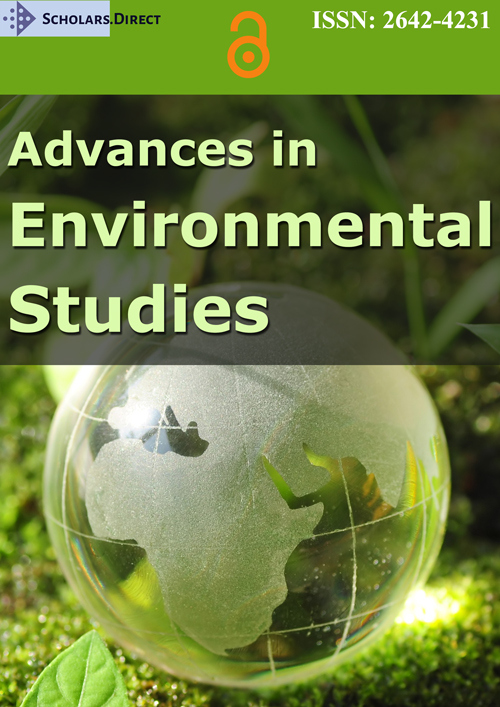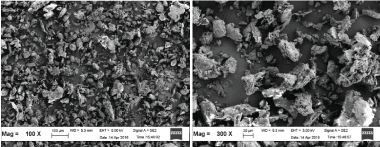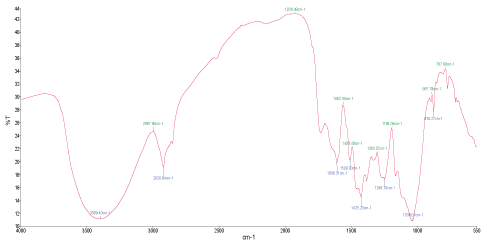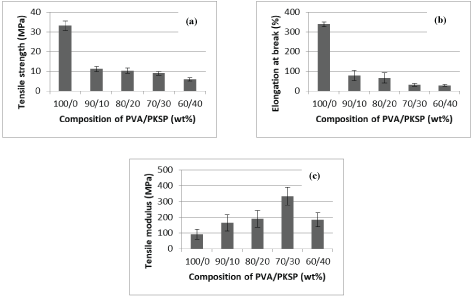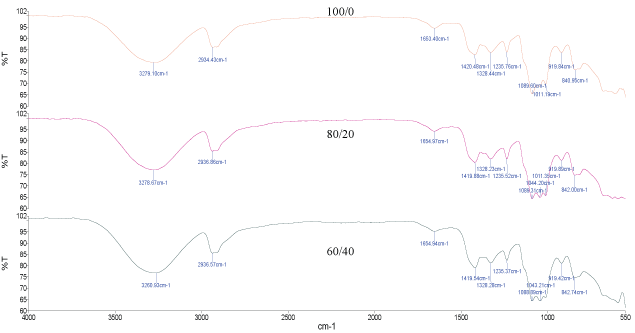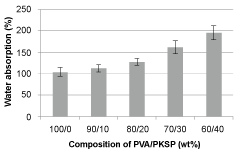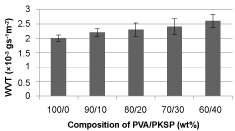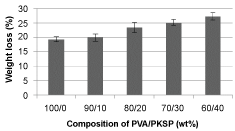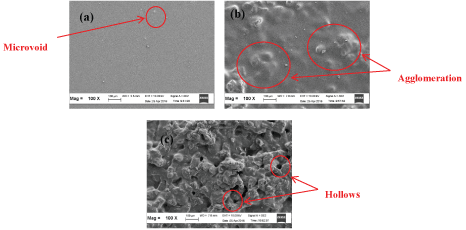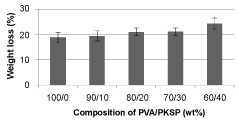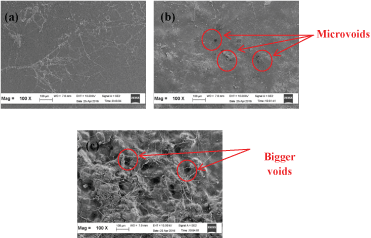Development of New Material Based on Polyvinyl Alcohol/Palm Kernel Shell Powder Biocomposites
Abstract
New biocomposite films from Polyvinyl alcohol (PVA)/Palm kernel shell powder (PKSP) were prepared by solution casting method. The effect of PKSP addition on the film was studied based on the tensile properties, physical properties and biodegradability. From tensile test, it was found that the tensile properties decreased with the increasing PKSP loading in the composition. This is due to the poor interfacial adhesion and agglomeration of PKSP at high filler loading as proven by SEM micrograph. The water absorption and water vapour transmission (WVT) were also increased with PKSP loading. Higher weight loss in biodegradability test, indicating the PVA/PKSP biocomposite films had higher biodegradability compared to neat PVA film.
Keywords
Biocomposites, Palm kernel shell, Polyvinyl alcohol
Introduction
Petroleum derived polymers have been used widely in many applications such as packaging, automotive, agricultural and medical appliances. Since polymeric materials do not decompose easily, disposal of plastic waste is a serious environmental problem. Therefore, the development of biodegradable polymers has been a major interest recently. Polyvinyl alcohol (PVA) is a useful polymer, which have been synthesised with a backbone consist primarily of -OH bond. The hydroxyl group makes it highly biodegradable and highly soluble and therefore widely used for packaging application. The advantages of PVA are good film formation, strong conglutination and high thermal stability. Generally, PVA films have been used for packaging application, where the contents need to be dissolved or dispersed in water because it is water soluble. Besides that, PVA is used to be blended with other polymer to enhance the solubility and polarity [1].
Composite is defined as any multiphase material that exhibits a significant proportion of the properties of both constituent phases such that a better combination of properties is realized. In addition, the constituent phases must be chemically dissimilar and separated by distinct interface. Typically, composite materials have two phases, which are the matrix and the reinforcement phase. Recently, most researchers are interested to utilize agricultural wastes as reinforcing fillers due to growing environmental awareness. Natural fibers offer several advantages over the conventional, human-made fibers. Most of these fibers are environmental friendly, highly biodegradable, easily and abundantly available, relatively cheap and low density. As the plant fibers are biodegradable, they are able to contribute to better ecosystem and at the same time their low cost and performance can fulfil the economic interest in industry [2]. Most widely used biodegradable filler are lignocellulose-based fibers.
Palm kernel is obtained from the oil palm fruit and it is actually the by-product from palm oil industry [3]. Malaysia is the second world largest producer of palm oil after Indonesia. As palm tree is perennial crop, it is available all over the year, which means palm kernel shell is always available [4]. Initially in the crude palm oil process, steaming treatment is carried out to melt the fruit's flesh. The residual fruits are crushed mechanically to extract the seeds or kernels, known as palm kernel shells. During palm oil processing, the kernel will be separated and kernel oil will be further distilled. The processing results in the production of wastes such as palm oil mill effluent, empty fruit bunches, mesocarp fibre and shell.
Several studies have been reported on the usage of palm kernel shells as filler in polymer matrices, such as low density polyethylene [5], polypropylene [6], high density polyethylene [7], recycled polyethylene [2,8] and polyester [9]. To the best of our knowledge, there is no study on incorporation of palm kernel shells into PVA matrix. The purpose of this research is to study the effects of adding palm kernel shell powder into polyvinyl alcohol for biocomposite film application. The palm kernel shell powder will act as the natural filler in the biocomposite that will affect its properties and contribute to biodegradability. PVA/PKSP biocomposite is targeted to be used in packaging application, which require moderate strength and higher biodegradability after end use. The effect of PKSP composition on tensile properties, morphology, water absorption, water vapour transmission and biodegradability of PVA/PKSP films were studied.
Experimental
Materials
Polyvinyl alcohol (PVA) with average molecular weight of 89000 to 98000 g/mol and density of 1.3 g/cm 3 was supplied by Sigma-Aldrich (M) Sdn. Bhd (Kuala Lumpur, Malaysia) Palm kernel shell powder was prepared using palm kernel shell from Malpom Industries (M) Bhd, Nibong Tebal, Penang. Glycerol and tween 80 were supplied by Merck, while hexamethylenetetramine was purchased from Fluxa Chemical. All chemicals were analytical grade reagents.
Methods
Palm kernel shell powder (PKSP) preparation
The PKSP was prepared by grinding the palm kernel shell by using mini crusher from Chyun Tseh Industrial Co. LTD, Taiwan. Sieving process was carried out by using 3 sieving plates with size of 1000, 600, and 75 microns. The PKSP was kept in a dessicator for subsequent composites preparations.
Biocomposite preparation
200 ml of de-ionized water was measured and 100 ml was poured into another beaker containing PVA. After PVA dissolved, it was then added to the initial beaker. The mixture was stirred for 10 minutes at 95 ℃. The PKSP was added and continued to stir for 10 minutes. The additives were added and let to stir for another 10 minutes. After gelatinization, the solution was casted over glass plates and dried at room temperature for 24 hours. The film was then further dried in oven for 2 hours at 70 ℃. The film with average thickness of 0.15 mm was peeled off and reserved for further testing. PVA/PKSP biocomposite was prepared at five different ratios, varying the PKSP loading from 0 wt% to 40 wt% as shown in Table 1.
Tensile properties
The tensile properties of the films were evaluated by using Instron 3366 testing machine. Five dumbbell shaped samples (ASTM D638) were cut and then the thickness along the test length was measured at three different places using thickness gauge. The crosshead speed used for tensile test was 50 mm/min and the load cell was 10 kN. The gauge length, which is the gap between upper and lower clamp was set at 50 mm. The test was carried out at room temperature and an average value five repeated tests were taken for each blend composition.
Chemical composition by fourier transmission infrared (FTIR)
The functional group of samples was analyzed using Fourier transform infrared spectroscopy (FTIR) equipped with Attenuated total reflectance (ATR) mode. For sample preparation, the films were cut into dimension of 10 mm × 10 mm. The sample was placed on base optics assembly and the spectra were recorded. The characterization was taken place ranges from 400 to 4000 cm-1 in 16 times of scanning in order to reduce noise and to prevent overlapping of spectrum. The means of the peaks in FTIR spectrum were used to determine the chemical structure in the samples.
Morphological study
Morphological study of the biocomposite was carried out by Field Emission Scanning Electron Microscope, FESEM Supra 35VP. The tensile-fracture surfaces of the films were observed to study the failure modes and filler distribution. The surface morphology of each film was observed by using Scanning electron microscope (SEM) for biocomposite films after exposure to natural weathering and soil burial. The sample preparation needed to be carried out before observing the morphology, in which the film was mounted on aluminium stubs with carbon tape and then sputter coated with thin gold layer to avoid charging and poor resolution during examination.
Water absorption
The water absorption (Wa) of films was performed as described by Yun, et al. [10]. Dried plastic films were immersed in distilled water at room temperature (25 ℃). After the 24 hours, moisture on the surface of the films was removed and the weight of the films was measured. The water absorption of the plastic films was calculated as:
We is the weight of plastic film at the adsorbing equilibrium, and Wo is the first dry weight of plastic film.
Water vapour transmissibility
Water vapour transmissibility (WVT) was measured by performing testing according to ASTM E96-80 (ASTM 1998), modified by Gontard, et al. [11]. A container of about 30 ml distilled water was sealed on top by film sample. The initial weight of container sealed with film sample was weighed and recorded. For each blend compositions, five containers were prepared. Then, containers were all placed in the desiccator at room temperature. The containers were weighed daily using analytical balance until constant weight.
The WVT was then calculated according to:
where G is the weight gain, t is the time and A is the area of test area.
Natural weathering
The samples were cut into dumbbell shape (ASTM D882) from the film of each composition. The samples were subjected to weathering test for 14 days (March 2016). The test was carried out according to the ASTM D1435. The weathering resistance and the degradation of the samples were determined by observation on the changes in dimension, physical appearance and weight changes.
Soil burial
The samples were cut into dumbbell shaped and buried in the natural soil at School of Materials and Mineral Resources Engineering, Universiti Sains Malaysia in Nibong Tebal, Penang for a period of 14 days (March 2016). The buried specimens were collected from the soil and the dirt was removed. The weights of the buried samples were recorded and the weight changes were calculated. The degradation of the samples was determined by observation on the changes in dimension, physical appearance and the weight changes.
Results and Discussion
PKSP characterization
Figure 1 shows the SEM micrograph of PKSP at magnification of 100X and 300X. Apparently, the agglomeration of PKSP is found. The microstructure of palm kernel shell powder reveals that the size and shape of particles vary, and they consist of porous irregular shape particles.
FTIR spectroscopy was used to seek evidence of the functional group presence in PKSP. Palm kernel shells are one of the lignocellulose fibers that are basically made up from cellulose, lignin and hemicellulose [12]. Figure 2 shows the spectrum of PKSP which show the characteristic absorption bands. The spectrum of raw PKSP shows many peaks belong to various functional groups. The strong broad absorption band at 3399.40 cm-1 is assigned to the OH stretching vibrations, which is typically in range from 3200-3600 cm-1. A strong and sharp peak at 2920.84 cm-1 indicates the existence of C-H stretching in the methyl groups. The band located at 1608.31 cm-1 corresponded to stretching of C=C carbonyl group in aromatic compounds. For C-C stretching band in ring or aromatic compounds, a peak within 1500-1400 cm-1 is typically observed. In the spectrum, a peak is revealed at 1425.20 cm-1. Another peak is observed at 1036.01 cm-1 could be assigned to stretching of C-O, which is found in esters, carboxylic acid, ethers and phenols.
Tensile properties
The mechanical behaviour of polymers can be investigated by stress-strain characteristics under elongation or tensile deformation. Tensile properties of polymer can be characterized via modulus of elasticity, stiffness, elongation at break, ultimate tensile strength, toughness and creep [13]. Figure 3a shows the variation of tensile strength with filler content. It is observed that the tensile strength of film exhibits significant decreased with increasing filler content. The decrement in tensile strength may be due to poor interfacial adhesion and distribution of filler within the matrix, thus providing poor reinforcement.
Addition of filler in matrix is not necessarily will enhanced all properties of composite. Several factors such as interfacial adhesion, compatibility and type of filler contribute to the final properties of composite. The strength of particulate filled polymer composites depends to a great extent on the interfacial adhesion between the matrix and the filler which facilitate the transfer of small section of stress to filler particle during deformation [14]. According to Morreale, et al. [15], better stress transfer from matrix to filler can be achieved by strong adhesion between matrix and filler interface, in which leads to a higher tensile strength. The distribution of filler at higher filler content was poor (as shown later in morphological study, and this caused the stress in the continuous phase to increase and resulted poor tensile strength.
Elongation at break as shown in Figure 3b showed decreasing trend as filler content increased. The decrease in elongation at break is the indication that the filler is incapable of supporting the stress transfer from filler to matrix. The incorporation of filler within PVA matrix decreased the elasticity of the film. Higher filler loading in PVA matrix resulted in the stiffening and hardening of the film. This reduced its resilience and toughness, and led to lower elongation at the break [16]. The incapability of the filler to support stress transfer is indicated by the decrement of elongation at break. Basically, the stiffness of the film increased gradually with an associated decrease in elongation at break. Several researchers also report similar trends on mechanical properties of incompatible filler and matrix [17-19]. Besides that, the decrement of elongation at break in presence of PKSP may be due to PVA matrix ductility being severely altered by micron sized filler.
Figure 3c shows the tensile modulus as function of filler content. Initially, as PKSP is incorporated into the PVA film, the tensile modulus increases. The increased modulus corresponds to more filler where its intrinsic properties exhibit high stiffness compared to polymeric material. Modulus increased because the stiffening effect of the granules. The incorporation of PKSP into PVA has led to an increase in the modulus because PKSP is stiffer than PVA matrix in which they are dispersed.
The tensile modulus of the biocomposite decreases with increases in filler content beyond 30 wt% PKSP. The decrement in tensile modulus shows poor resistance of material to deformation. This is because at high filler content the biocomposite film is unable to withstand greater loads. This may indicate that the incorporation of PKSP into PVA matrix introduces a new interfacial region that affects the stress transfer in the film. In other words, the applied stress failed to transfer throughout the samples effectively. Besides that, Nair, et al. [20] reported that beyond the maximum loading of filler, tensile behaviour may drop due to agglomeration of filler, leading to poor stress transfer.
Fracture surface morphology
Morphological study and structure-property correlations of polymers including homopolymers, copolymers blends and composites are vital in characterization, which are complemented by electron microscopy. SEM is used to study the tensile-fractured surface morphology of PVA/PKSP films produced. Morphological analysis using SEM clearly shows difference in the surface of the neat PVA film and PVA/PKSP film. As PKSP is added into PVA, morphological changes in the structure took place. As shown in Figure 4a the fracture surface for neat PVA film is relatively smooth compared to filled PVA film (Figure 4b). Both flat surface and shear lips are present on the fracture surface, which indicates mixed mode fracture. The wavy surface showed that the crack propagation is unstable.
On the other hand, the fracture surface of PVA with 40 wt% PKSP is uneven and some cavities was shown in Figure 4b. As PKSP loading increases, more filler pull-out is observed. The cavities left by de-bonded fillers indicated the tensile fracture is mostly via debonding. When filler-matrix interface is weak, the force for PKSP pull out will be lower. Besides that, the tendency of filler agglomeration is higher when the filler loading increases. The agglomeration produce discontinuity in matrix, in which creating a stress concentration point. These observations support the results of tensile strength of film with 40 wt% PKSP has lower tensile strength compared to low filler loading and neat PVA. Tiwari, et al. [21] also reported similar findings in polyvinyl chloride/rice husk ash composite at higher filler loading.
Chemical composition by Fourier Transmission Infrared (FTIR)
FTIR spectroscopy is used to seek an evidence of the functional groups in the films with different PKSP loadings. Figure 5 shows the FTIR spectrum of neat PVA, 80/20 PVA/PKSP and 60/40 PVA/PKSP biocomposite. It shows that various absorption bands are observed. For neat PVA film, the significant peak of intensity around 3279.01 cm-1 is assigned to hydrogen bond from alcohols or phenols. The peak is very broad due to the strong hydrogen bonding and thus obscures other bands in this region. The absorption band at 2935.99 cm-1 was associated with alkane group. The peak is produced as the C-H bonds stretch.
At the fingerprint region, the bending vibration for O-H is found at 1419.41 cm-1. The C-O absorption bands can also be found at 1010.23 and 1090.08 cm-1. These bands generally used as the conformation of alcohol group in the sample. The peaks from 600 to 900 cm-1 are mainly due to the rocking vibration of C-H bond. Addition of PKSP into PVA matrix affects the chemical composition of the film. Even small differences in structure and constitution of molecules may result in significant changes in the peaks especially in between 1200 to 700 cm-1, which is also known as the fingerprint region. For instance, the significant peak of hydroxyl group in neat PVA film is at 3279.10 cm-1. However, the wavelength shifts to 3278.67 cm-1 and 3260.93 cm-1 respectively for 20 wt% and 40 wt% PKSP loading.
It is observed that the peak of O-H bending vibration is less intense for PVA/PKSP film than the neat PVA. This is due to the fact that weight percentage of PVA decreased, causing the amount of hydroxyl group to reduce. Besides that, hydroxyl group also may be used for filler-matrix interaction. Around fingerprint region, almost similar peaks are observed between the biocomposite and neat PVA film. These peaks are mainly contributed by alkenes, hydroxyl and carbonyl groups. In comparison to the neat PVA, PVA/PKSP films show few additional peaks in the fingerprint region. The additional peaks are at 1043.92 cm-1 for 80/20 film and 1043.06 cm-1 for 60/40 film. These peaks are attributed to the C-O vibrations in PKSP.
Water absorption
Water absorption test is crucial to determine the water absorptivity of the material especially in packaging application. The presence of hydroxyl groups enables hydrogen bonding to be formed in water, making PVA highly hydrophilic and bio-compatible [22]. Figure 6 shows the variation of percentage of water absorption with different filler contents. It is observed that the composite with higher PKSP content has higher water absorbing capacity. As the filler content increases, the formation of agglomeration increases due to the difficulties of achieving a homogenous dispersion of filler at higher filler loading content within the matrix. The agglomeration of filler increases the water absorption of composites.
The PVA filled with PKSP demonstrated higher water absorption than pure PVA film. This was due to poor interaction between PKSP and the matrix that increased the water absorption. Poor compatibility between the PVA and PKSP at higher filler loading is predicted and shown by the reduction of tensile properties as reported earlier. This will increase the freely available hydroxyl groups and exposed more water-binding site. This is in agreement with work earlier on mechanical and water absorption properties of PVA/sago starch pith waste composites [23]. Besides that, PKSP is polar and it contains hydroxyl groups that bind with water molecules. The presence of hydroxyl groups in PKSP also attributed to higher water uptake due to the formation of hydrogen bonding. As higher PKSP loading is incorporated into the films, the more hydroxyl group will present, therefore increases the water absorptivity.
Water vapour transmission
Water vapour transmission (WVT) is a measure of how much water vapour able to pass through a material per unit area per unit time. Figure 7 signifies the effect of PKSP loading on the water vapour transmissibility of PVA/PKSP films. It is clearly shown that the WVT increased with increasing PKSP loading. The hydrophilic nature of PVA and PKSP enhances the absorption of water molecules and at the same time increases the WVT. The increment of WVT is caused by polarity of lignocellulosic nature of the filler, in which it has the tendency to absorb water and moisture. The cellulose content has hydroxyl group on its surface, producing hydrogen bond with water.
The ability to transport moisture over a film can be favourable property in some applications such as in food waste collection system and garden waste sacks. High WVT will improve the quality of the waste for composting plant. High WVT will avoid fermentation and bad smell, mould and leachate. The increment of WVT at higher filler loading may be due to the fact that the water sensitivity of the films increased due to more hydroxyl group present. WVT is highly affected by the diffusivity and solubility of water molecules in the film matrix [24].
Natural weathering
Natural weathering involves the outdoor exposure of samples, mounted on testing racks, oriented under standard conditions in order to expose samples to full radiation spectrum, temperature and humidity of the testing location. Figure 8 shows the dependence of weight loss on the composition of PVA/PKSP film. The increase of PKSP loading leads to the increment of weight after exposure to natural weathering test. For PVA, the degradation mechanism is unusual as it occurs randomly along the PVA polymer chain. Typically many other polymers degrade from chain ends.
Weathering
Several mechanisms may participate in the degradation of PVA such as oxidation of hydroxyl groups to ketone groups and formation of acetic acid, alcohols and ketones which may further metabolized to water and carbon dioxide [25]. The degradation is much more pronounced when PKSP loading is high. It is shown that the incorporation of PKSP with PVA can increase the degradability of PVA films. This is due to the ability of PKSP to absorb more moisture, enabling the degradation via hydrolysis to occur within the film. Besides that, both PVA and lignin in PKSP are able to undergo photodegradation when being exposed to UV.
The evidence of the degradation of PVA/PKSP films after natural weathering is shown in Figure 9. Degradation via natural weathering can be initiated by various mechanisms, such as photodegradation, hydrolysis and oxidation-depolymerization. For neat PVA film, only few micro voids are observed on the surface. As PKSP is incorporated, the surface roughness increases, due to filler agglomeration. In addition, formation of micro void and surface erosion were also found on the surface. The severity of deterioration increases with increasing filler loading. The losses in mechanical and physical properties are caused by the deterioration of film. This is in agreement with the reduction of the tensile properties.
Soil burial
In order to evaluate the degradation occurred during soil burial test, the weight loss of the films is measured. Figure 10 shows the weight loss of the pure PVA and PVA/PKSP films in soil. The weight loss is a reflection of the biodegradation process by the moisture and microorganism in the soil. In comparison to the pure PVA film, the film incorporated with PKSP shows higher weight loss after being buried for fourteen days. As the filler loading increases, the weight loss for the film also increases. This shows that the incorporation of PKSP in PVA film improves the film biodegradability.
The result obtained can be associated with the organic compounds in the PKSP and make it vulnerable to attack by microorganism. As reported in other studies, microorganisms require a moist environment to survive and able to export hydrolytic enzymes that break down the biopolymers [26]. When the sample is buried, the water and moisture diffuse into the sample, causing it to swell and enhanced the biodegradability. Based on water absorption test, it was shown that the water uptake increases as the PKSP loading increases. Therefore, the sample with highest water absorption capability tends to enhance the biodegradability of the film the most. Besides that, the condition of the natural soil can provide realistic environment where humidity, temperature, pH value and type of microorganism are less controlled and changed by the seasons [27].
The surface morphology of PVA/PKSP films after soil burial is shown in Figure 11. Traces of soil that diffused into films and microorganisms are observed. For neat PVA film, the surface is found to be smoother than biocomposite film. As PKSP loading increases, the surface roughness of the film also increases. This is due to agglomeration of filler. At 20 wt% PKSP loading, small hollows appeared and some cracks are found on the surface. The severity of surface deterioration increases at 40 wt% filler loading as more holes appeared and more filler popped out.
Conclusions
1. In this study, the preparation of PVA/PKSP biocomposite is successfully achieved by solution casting method. Addition of PKSP to PVA is found to affect the tensile properties and the biodegradability of the films.
2. The tensile properties decreased with increasing PKSP loading.
3. Besides that, water absorption and water vapour transmission of film increased with increasing PKSP loading. Water soluble nature of PVA and water sensitivity of PKSP is believed to be the reason as both of them have hydroxyl group in the chemical structure.
4. The biocomposite film is shown to have higher biodegradability with addition of PKSP. Based from natural weathering and soil burial test, the weight losses increased with increasing PKSP loading, which indicates that the films are able to degrade faster.
Acknowledgement
The support provided by Universiti Sains Malaysia is fully acknowledged, and the financial support for N. F. Alias under MyBrain15 from Ministry of Higher Education is mostly appreciated.
References
- Alexy P, Bakos D, Crkonova G, et al. (2003) Poly(vinyl alcohol)- Collagen Hydrolysate Thermoplastic Blends: II. Water penetration and biodegradability of melt extruded films. Polymer Testing 22: 811-818.
- Olumuyiwa A, Isaac T, Adewunmi O, et al. (2012) Effects of Palm Kernel Shell on the Microstructure and Mechanical Properties of Recycled Polyethylene/Palm Kernel Shell Particulate Composites. Journal of Minerals and Materials Characterization and Engineering 11: 825-831.
- Dagwa IM, Builders PF, Achebo J (2012) Characterization of Palm Kernel Shell Powder for Use in Polymer Matrix Composites. International Journal of Mechanical and Mechatronics Engineering 12: 88-93.
- Edmund CO, Christopher MS, Pascal DK (2014) Characterization of Palm Kernel Shell for Materials Reinforcement and Water Treatment. Journal of Chemical Engineering and Materials Science 5: 1-6.
- Romisuhani A, Salmah H, Akmal H (2010) Tensile Properties of Low Density Polypropylene (LDPE)/Palm Kernel Shell (PKS) Biocomposites: The Effect of Acrylic Acid (AA). IOP Conference Series: Materials Science and Engineering 11.
- Jain KP, Shit SC, Jain SK (2013) Evaluation of Mechanical & Thermal Properties of Polypropylene - Palm Kernel Nut Shell Powder Composites for Green Roof Technology. Journal of Information, Knowledge and Research in Mechanical Engineering 2: 456-459.
- Ishidi EY, Adamu IK, Kolawale EG, et al. (2011) Morphology and Thermal Properties of Alkaline Treated Palm Kernel Nut Shell - HDPE Composites. Journal of Emerging Trends in Engineering and Applied Sciences (JETEAS) 2: 346-350.
- Samotu IA, Dauda M, Anafi FO, et al. (2015) Suitability of recycled Polyethylene/Palm Kernel Shell-Iron Filings Composite for Automobile Appliction. Tribology in Industry 37: 142-153.
- Shehu U, Aponbiede O, Ause T, et al. (2014) Effect of Particle Size on the Properties of Polyester/Palm Kernel Shell (PKS) Particulate Composites. Journal of Materials and Environmental Science 5: 366-373.
- Yun YH, Wee YW, Byun HS, et al. (2008) Biodegradability of Chemically Modified Starch (RS4)/PVA Blend Films. Part CC2. Journal of Polymer Environment 16: 12-18.
- Gontard N, Guilbert S, Cuq JL (1993) Water and Glycerol as Plasticizers Affect Mechanical and Water Vapour Barrier Properties of an Edible Wheat Gluten Film. Journal of Food Science 58: 206.
- Noorshamsiana AW, Nureliyanti AO, Fatiha I, et al. (2018) A Review on Extraction Processes of Lignocelulosic Chemicals from Oil Palm Biomass. Journal of Oil Palm Research 29: 512-527.
- Alavi S, Thomas S, Sandeep K, et al. (2015) Polymers for Packaging Applications. Toronto: Apple Academic Press.
- Sherman D, Brandon D (1999) Mechanical Properties of Hard Materials and their Relation to Microstructure. Advanced Engineering Materials 1: 161-181.
- Morreale M, Scaffaro R, Maio A, et al. (2007) Effect of Adding Wood Flour to the Physical Properties of Biodegrdable Polymer. Composite 42: 214.
- Jacob M, Thomas S, Varughese KT (2004) Mechanical Properties of Sisal Oil Palm Hybrid Fiber Reinforced Natural Rubber Composites. Composites, Science and Technology 64: 55-965.
- Tong J, Royan N, Ng Y, et al. (2014) Study of the Mechanical and Morphology Properties of Recycled HDPE Composite Using Rice Husk Filler. Advances in Materials Science and Engineering 1-6.
- Lim B, Salmah H, The P (2012) A Study on the Rheological Properties of Low-Density Polyethylene/Palm Kernel Shell Composites. Advanced Material Research 626: 615-619.
- Bruer O, Tchoudakov R, Narkis M, et al. (1997) Segregated Structures in Carbon Black-Containing Immiscible Polymer Blends: HIPS/LLDPE Systems. Journal Applied Polymer Science 64: 1097-1106.
- Nair MM, Shetty N, Shetty SD, et al. (2018) Effect of Distilled and Sea Water Absorption on Mechanicl Behaviour of ShortCoir Fibre Epoxy Composite/Sawdust Filler. Pertanika J Sci Technol 26: 261-282.
- Tiwari P, Choudhary S, Chaudhary M (2015) Study on Mechanical, Thermal and Morphological Properties of RHA Filled PVC Composite. International Journal of Scientific Engineering and Applied Science 1: 265-281.
- Figueredo KCS, Alves TLM, Borges CP (2009) Poly(vinyl alcohol) Films Crosslinked by Glutaraldehyde under Mild Conditions. Journal of Applied Polymer Science 111: 3074-3080.
- Toh WY, Lai JC, Wan Aizan WAR (2011) Influence of Compounding Methods on Poly(vinyl) alcohol/Sago Pith Waste Biocomposites: Mechanical and Water Absorption Properties. Sains Malaysiana 40: 719-724.
- Gontard N, Guilbert S (1994) Biopackaging: Technology and Properties of Edible and/or Biodegradable Material of Agricultural Origin. Food packaging and preservation. Mathouthi M, Blackie Academic and Professiona, London, England.
- Sakai K, Hamada N, Watanabe Y (1986) ß-diketone hydrolase from Pseudomonas sp. Agric Biol Chem 50: 989-996.
- Khachatourians GG, Qazi SS (2008) Entomopathogenic Fungi: Biochemistry and Molecular Biology. Brakhage AA and Zipfel PF, Human and Animal Relationship, New York.
- Ismail H, Zaaba NF (2012) The Mechanical Properties, Water Resistance and Degradation Behaviour of Silica-Filled Sago Starch/PVA Plastic Films. Journal of Elastomers and Plastics 46: 96-109.
Corresponding Author
Hanafi Ismail, School of Materials and Mineral Resources Engineering, Universiti Sains Malaysia, 14300 Nibong Tebal, Penang, Malaysia.
Copyright
© 2018 Alias NF, et al. This is an open-access article distributed under the terms of the Creative Commons Attribution License, which permits unrestricted use, distribution, and reproduction in any medium, provided the original author and source are credited.

